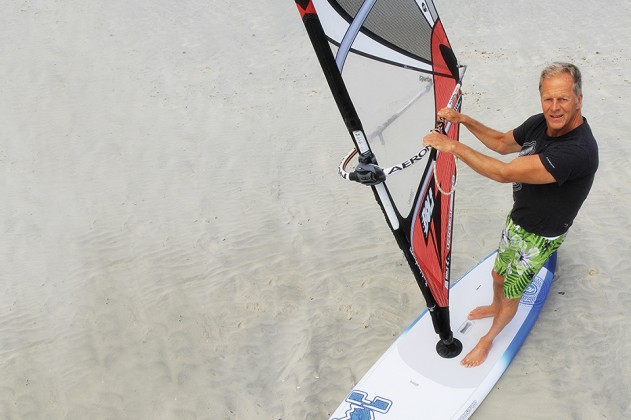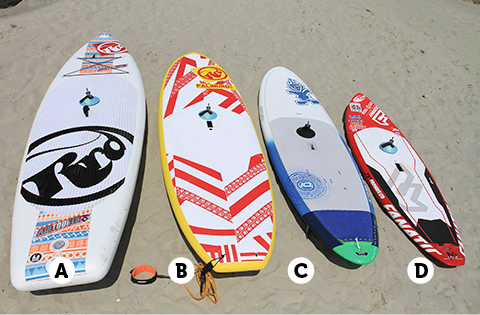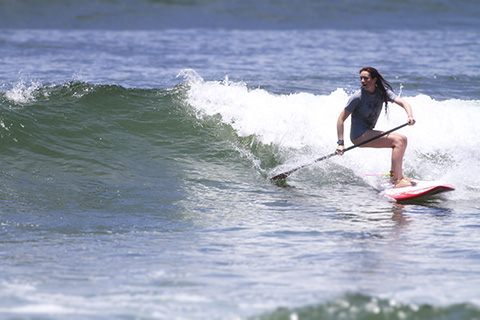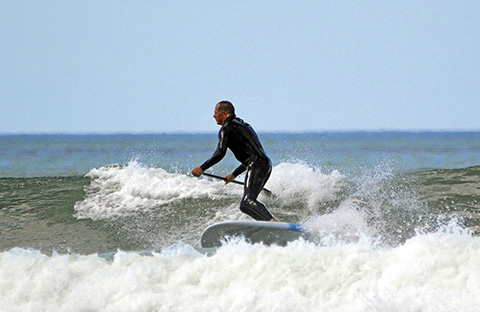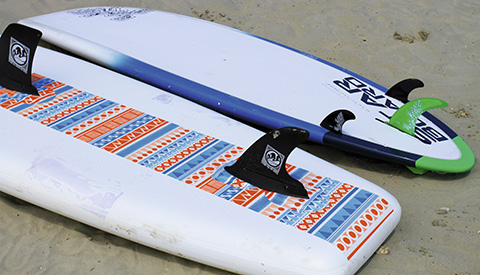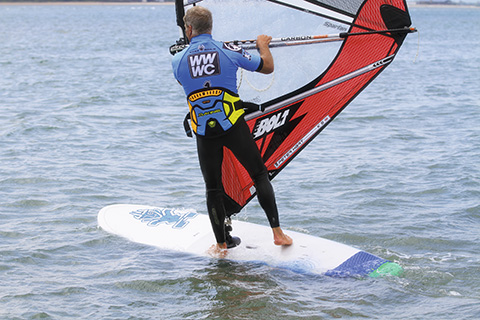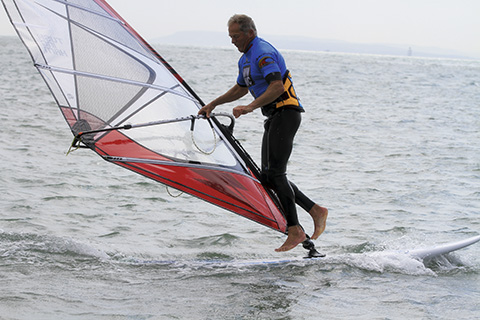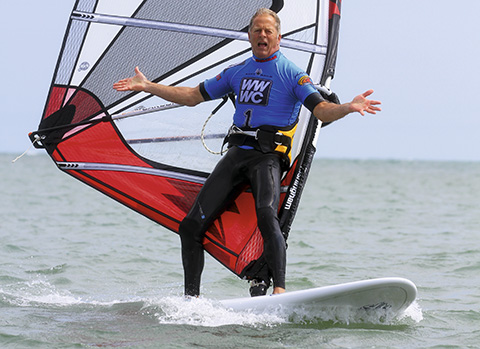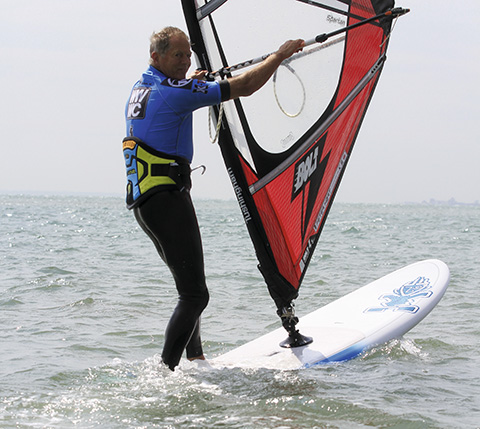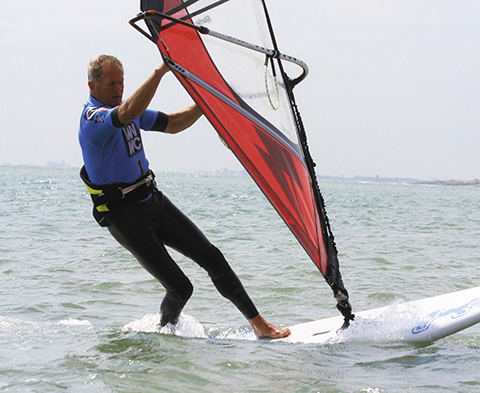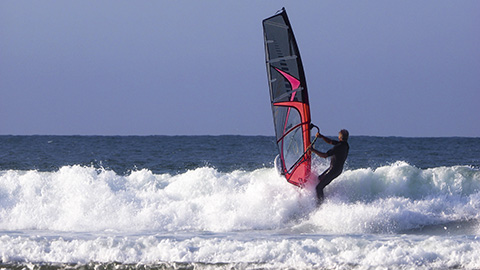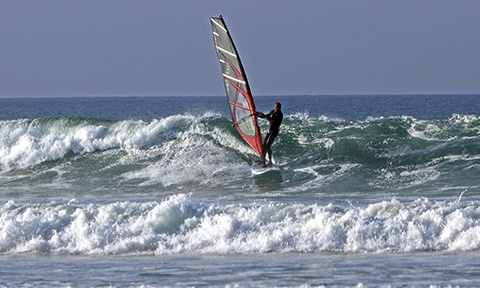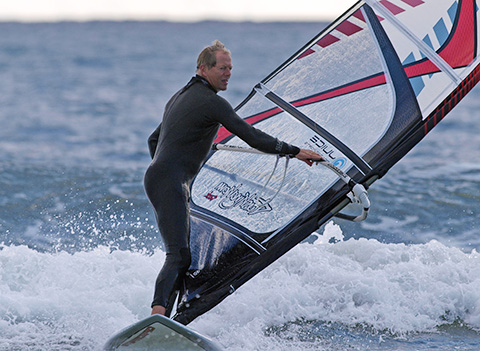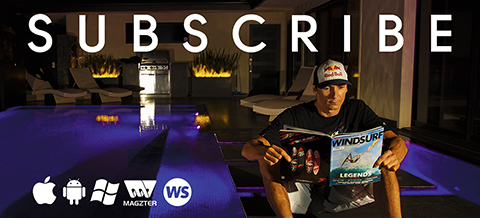STANDING UP AND SAILING
Words Peter Hart // Photos Simon Basset and Hart Photography
Harty reckons WindSUPing is best thing that has happened to windsurfing in ages. It brings a true purpose to light wind days; it plugs gaps in the armoury of the blasting intermediate’s technique, and offers a pain-free path into the waves. Let him help you choose one, set it up and tweak your technique to sail it.
To those from the black and white era, their first go on a WindSUP is like coming home – except they find that this home doesn’t leak, has under-floor heating, an indoor toilet, a home cinema and a Jacuzzi. For those of a more recent, wider generation, the comment is more: “this is weird … different … but… actually … feels … amazing …”
I was handed my first SUP in 2006. I’d noticed there was a little hole hidden within the soft EVA deck which accommodated a mastfoot, but it was 6 months before I thought of actually using it. It was in Kerry on a ‘nothing’ day – 8-10 knots of cross-on north westerly with a weak, messy waist-high wind swell. Not enough wind to plane; not enough punch in the wave to surf or make it worthwhile bogging out on a wave board; but enough wind and chop to render this new Stand Up Paddle surfing game quite annoying. Might as well stick a sail in it and see what gives. Cut to the Hollywood ending and for an hour and a half I was the only one having any fun – and I was having loads of it.
It caught the merest hint of a swell. I was up and riding the unbroken face before it was even a face. And thanks to its waterline length it generated lots of speed in decidedly un-speedy situations.
Back in the day I used to take my original 3.8m Sea Panther out into the waves – but mostly under them. On those old rocker-less boards, as soon as you caught a hint of a swell, you had to sprint back into the aft cabin to have any chance of preventing a nose-dive. But this beauty just bottomed out and kept on trucking. Having realised it was really just a long surfboard, I then … surfed … properly … as in, did turns on the face, not just bumble along in the trough. Like a 9’ 6” Malibu you had to turn it off the tail but then you had this big platform on which to cruise or do stuff. Suddenly I was back showing off on Bray Lake in 1982 – riding back-winded, inside the boom, ducking the rig – it was old school heaven made easier by having a little reform wave to push me along and take the power out of the sail.
And that was just the beginning …
I’ve never had anyone on a course, who after having used a WindSUP for the first time, either in the waves or for light wind skills, haven’t immediately threatened to go out and buy one.
BECOME A ‘WATERMAN’ (OR WOMAN)
Ask anyone why they aren’t a better windsurfer and they will chant the old ‘Not enough time on the water …’ hymn, shrugging helplessly at the impossibility of striking a work, family, ‘me time’ balance in the hectic twenty first century. I empathise. But the blame lies with the self and their interpretation of ‘water time,’ which in their eyes only counts as such if they’re powered up with a 6.5 or preferably a lot less.
What the WindSUP does is introduce you to the ‘waterman’ mind set; which is: “I haven’t seen a forecast but I’m going to the beach anyway and will do whatever activity is appropriate for the conditions.”
Now already you’re thinking of a Kai Lenny character with a customised monster truck laden with 20k’s worth of kit from 5 different watersports. Nice work if you can get it, but a well-chosen WindSUP along with your regular gear guarantees you will always get wet in a way that is entertaining and relevant to your windsurfing. The initial challenge is getting the right one.
THE BURDEN OF CHOICE
I handed a brochure to a guy who had been truly seduced by his first WindSUP experience. But after a quick flick-though, his face had the look of an Eskimo who had been asked to read a tome on astrophysics in Chinese. The choice was vast, which is more a testament to the SUP’s versatility than the brand’s perverse desire to confound the buyer.
It’s actually not so hard to choose if you’re honest about who is mostly going to use it and what for.
For a start it has to have a mastfoot and that eliminates a fair proportion of the brochure options. And then the specific questions to be answered are …
SOLID OR BLOW UP?
The inflatables, or ‘lilos’ as one of my dear sponsors lovingly calls them, have become astonishingly good – getting stiffer all the time and incredibly robust. They cruise beautifully in light winds and their inherent ‘squidginess’ feels friendly under the feet of a novice, or indeed anyone with office feet.
But in terms of performance, they can’t match a solid board – not yet anyway. So apart from a small price advantage (in some cases), the only real reason to favour one is convenience – no van, garage or roof rack needed. For many that is the most compelling reason. Solid SUPs take up a lot of space.
The main performance issues come down to the inflatable construction allowing very little control over the shape of the rails. There is no choice but to make them thick nose to tail (their thickness gives the board its stiffness) and rounded. As yet it’s impossible to make an inflatable as hard (sharp) edged as a solid board. Sharp edges are vital for planing in that they give the water a release point. They offer essential resistance if you want to sail it upwind without a daggerboard; and thin sharp rails through the tail grip the water through carved turns. Thick rounded rails bounce and slide at speed. For those reasons, plus the fact it’s hard to build in rocker, inflatable WindSUPS are tricky in all but the smallest waves.
They offer the novice a gentle introduction to semi-planing. However, when it comes to the real thing, the extra force going through feet and mastfoot really makes even the most vigorously pumped inflatables bend like a banana. Suddenly you have a board with 6 inches of unwanted rocker that pushes a bow wave of ‘Jaws’ proportions. If planing is your main focus, buy a dedicated free-ride windsurfer specifically designed for the job.
But if it’s to be essentially a flat water, light wind option, you will be amazed at the inflatable’s ease of use and performance.
THE PRESSURE OF CHOICE
It’s barely a decade old and yet the choice of WindSUPs is bewildering. Deciding which way to go need not be so difficult if you’re honest as to its most likely role. Here’s a simplified range.
A: The 12 foot inflatable cross-over (has centre fin). 34” wide and 6” thick, it’s a mighty platform for touring, learning to windsurf and messing around. Compared to the solid boards the inflatable construction allows for little refinement in either the outline or the rail shape. So it’s not the one to bank into hard turns on steep waves but a brilliant beach companion.
B: The solid all-rounder. This one is 10’4” long and 34” wide and so aimed more at the heavier rider. As with their windsurfing boards, certain manufacturers are widening the outlines and thinning the rails. At this width, it will be easy to paddle, very stable for light wind windsurfing skills (also has optional centre fin) and is plenty long enough to give a long board, ‘glidey’ feel. It’s fine in small waves although that same width limits swift rail to rail turns.
C: The surf-oriented all-rounder. At 9’5” long and 30” wide, most chunky beginner SUPers would find this a challenge to paddle on anything but flat water. But it’s easy to windsurf and its surfboard rocker-line makes it a treat to turn and ride in even pretty big waves; AND to spin around on flat water. With no central fin, it’s not the best windsurf tourer. But as one board for the competent ‘windy’ with a degree of natural balance, it’s brilliant.
D: The no compromise, pro wave SUP. At just 7’6” long, 27” wide and with very thin rails, 99% of the population would have trouble paddling it lying down let alone standing up. It’s actually the board on which Holly Bassett of 2XS scored 16th in the World Champs. It does accommodate a mastfoot although it was never designed with windsurfing in mind – the rails are too thin to support the rig – although a small kid might have some fun. Its use is highly specific.
// Holly Basset of 2XS rig-less on her 7’6” at the recent SUP World Champs in Mexico.
WHY GET A WINDSUP?
Jamie Harman of RED Paddle Co. “I miss the days of being an instructor abroad and playing around in light winds. The main reason I didn’t do it more back in the UK was because I couldn’t free up the space or money for a big, old floaty free-ride board that in reality wouldn’t get THAT much use. But getting the 10’8 Ride inflatable WindSUP made perfect sense. It’s easy to store. My girlfriend can paddle it. I can teach my friends on it, I can go cruising and do all those old school tricks again.
WITH OR WITHOUT DAGGERBOARD OR CENTRAL FIN?
Unbelievable but true is that certain unscrupulous Windies (you know who you are), in search of a WindSUP for their personal use in waves, feign altruistic motives and sneak it through the household budget claiming it’s primarily for teaching family and friends. Now here’s your dilemma. If you really do want to teach beginners, you’ll need a dagger or option for a central fin. But the SUPs that perform in waves tend not to have them.
It’s hard to get a complete beginner going effectively without a central pivot point. They may chog off downwind but they’re unlikely to come back again. It’s not just a case of having some sideway resistance. There are a lot of unseen skills involved in sailing a long board (or any board) without a dagger – dipping the windward rail for resistance for example; using a scissor action of the feet combined with an upwind rig scoop to bear away.
And as for the WindSUP as a kid’s trainer, it depends on the size of the kid and the length of the SUP. Long edges resist turning. So under the pilotage of a child with a 2 sq m rig or less, no matter how vigorously they tilt it fore and aft, a long (10’ plus) SUP will turn very slowly, if at all.
The smaller WindSUPs can work for them but most don’t offer the central fin option. I taught my kids (7 and 5 at the time) on a 9ft, surf oriented WindSUP. I put in a bigger fin (28cm) and it worked OK. Staying upwind was still a mission early on until they learned to handle more wind. There’s a lesson for all there (sailing upwind is much easier if you’re powered up).
The key element is the distance between mastfoot and fin – the closer they are together, the easier the board is to sail and steer without a dagger.
ADVICE FROM DAVE WHITE – RRD AGENT
“Buy a board with a centre fin. Once you’re confident you’ll probably leave it in the bag most of the time. It makes life easy for ‘real world’ use – like when we’re learning or when we’re off on a windsurfing adventure leaving our launch spot miles behind – something most of us seldom do … but should.”
// Paddling the 9’5” surfy WindSUP. I can’t stress how useful this kind of exercise is for learning and improving your windsurf wave-riding. You work out how and where to take off and which part of the rail to engage in the turn. You start using the front foot as a platform – this position is exactly the same for bottom turning and gybing with a rig.
THE SIZE
As windsurfers, rightly or wrongly, we tend to be obsessed with litres. On SUPs, volume is still very relevant but try to associate performance more and more with length and width.
Width relates primarily to stability at rest and ease of remaining upright when paddling. Length relates to manoeuvrability and ‘glide.’ With a paddle the latter means how far the board goes with one stroke; with a rig it’s a measure of speed and momentum in non-planing winds and how sweetly it knifes through the water.
Your size choice depends on many factors but primarily:
– whether you want to use it a lot as a paddleboard?
– If so what type of paddling? Long distance cruising or waves or a bit of both.
– Where you sit on the Neuryev/Neanderthal spectrum of natural balance.
If it’s just for windsurfing, you can afford to go smaller in the knowledge you’ll always have a friendly rig to support you. But to eliminate the paddling option altogether, is to kind of miss the point.
Generalisations by their very nature are a bit unspecific but let me have a stab at translating various widths and lengths into feelings and performance under the feet of a 75kg averagely agile (whatever that is) adult; starting with widths. (Widths and lengths are quoted in feet and inches – it’s a long held surf shaper tradition.)
34” borders on a width for those who take an XXXL T shirt, or who are paid up members of the ‘special’ balance club. There are short and very wide boards that do work well in surf but the wider the board the more sluggish it is to move from edge to edge – and there’s a width beyond which a board just doesn’t fit on the face of a wave.
On the question of balance, one of the chief roles of a SUP without a rig is to help you refine your posture, sensitise your toes and heels and improve your balance. If you go for the aircraft carrier “because it’s easy,” the toes will remain ‘unsensitised’.
30-32” – reasonably stable but you can’t stamp around the edges and hope to get away with it. It’s the most popular width for all round boards – pretty easy to paddle even in chop; a forgiving base for light wind freestyle and yet narrow enough for easy footsteering.
sub 28” – getting very wobbly. For paddling, it requires refined balance skills or very flat water or a bit of both. The only reason to go this narrow or narrower is to rip it up in the surf.
LENGTHS
12’ plus – with or without a paddle, they’re made specifically for speed, glide and directional stability when cruising.
10-11’ – boards around this length fall into the ‘all-round’ or ‘50-50’ category – the most popular. They’re long enough to glide and go places and yet short enough to be work-able in small waves (The classic long ‘Malibu’ surfboard is around 9-10’ long). Although manoeuvrability in surf also depends on lots of other factors such as tail width and rocker.
9-10’ – Boards under 10’ tend to have a surf bias. You can still paddle long distances but will quickly be left behind by the longer boards. The shorter they get the more sensitive they are to the turning force of the paddle stroke meaning you have to change sides more often when paddling in a straight line. And with a surfboard rocker-line, they push more water and so slow down more quickly. But that also means they are more manoeuvrable both on and off a wave face, with or without a rig. For competent, medium weight windsurfers looking for a non-planing skills platform but mostly for a board that works in surf, this is the area you should look in.
Under 9’ – This is specialised territory. It’s for those who want to take their SUPing in waves to a proper surfing level. If you windsurf, you might as well get one with a mastfoot but I wouldn’t buy a board of this length specifically as a WindSUP. It’ll have about 120 litres or less so is too sinky and short for real light wind freestyle or for going places.
And if it’s a performance SUP for surfing, the rails will be very thin and there won’t be enough volume around the mastfoot to support a rig comfortably.
I’m not sure why you’d buy an 8’ WindSUP just for sailing in waves. Why not get the real thing? There are some incredible big, 110 ltr + wave boards out there which do the job a lot better.
// The difference in refinement between the inflatable and the solid board is plane to see. The thick round rails of the inflatable offer float and stability; the foiled rails of the hard board will offer grip in carved turns. Note the size of the fin – just 19cm. That’s pretty standard and allows you to launch and mess around in the shallows. You’re using it very differently from a planing free-ride fin. The side ‘thrusters’ help upwind but are there primarily to hold the tail in during surfing turns.
DISTILLING THE OPINIONS
The problem both for writer and potential buyer is that SUPs – wind and otherwise – are a work in progress. In its current form, it’s a fledgling sport. As they are bound to do, the brands are already forming contrary ideas as to what works under the feet of novice and expert. Some, as they have done with their windsurfing boards, are already going down the, wider, shorter, thinner rails, route. Others are staying more traditional. Let me finish this section with some personal opinions.
Don’t go too short and above all don’t let the size decision be dictated solely by the length of your van. The attraction of this new arm of the sport lies in its different-ness. If you go for a very short SUP, you might as well get a big free-ride board and take the straps off. And before some young tyke drones on about long being old ‘skool’ remind him how enormously popular the sport was back when boards were long. Part of that success was down to people having the tool that performed best for the conditions most wanted to sail in – i.e. force 2-3. Length brings a different experience and introduces you to a new set of skills.
More volume rather than less. Try out a few without a rig and be honest about how good your balance is or is likely to become? What’s easy on the flat waters of a lake is a lot harder on the undulating sea and even harder in breaking waves. The bigger the platform, the more general use you’ll get out of it and the easier it is to explore the freestyle options.
SKILLS FOR A WINDSUP
So what can a WindSUP bring to your game that a short, wide free-ride can’t? Leaving the waves aside for a moment (a SUP is much more versatile in surf), it’s basically length. Those brought up on long boards quickly develop a feel for longitudinal trim. In light winds they’re aware how an ounce of pressure fore and aft can be the difference between knifing and grinding through the water. In tacks and gybes the long edges grip the water and resist turns so you learn to make big pressure changes to release those edges and allow the board to pivot. One of the more advanced skills of gybing and wave riding is deliberately using different sections of the rails in the turn to lengthen or steepen the arc. On a long board you learn that concept in slow motion – and how moving as little as an inch further back can release the board. Short, wide boards can breed a static stance over the footstraps. But windsurfing is all about movement and long boards encourage movement. Do you know how far forward and back you can stand, especially on a wave, before it sinks – and how much you can alter the speed by moving forward and back? When it comes to taking the transitions to another level, notably heli-tacks, duck tacks, duck gybes etc, the biggest holes in people’s technical game are: sailing clew first and controlling the sail back-winded. The short board has the disadvantage that it turns very easily – so get the sail position a bit wrong and you find yourself turning off course. The long board forgives, keeps tracking straight and allows you to experiment and get a feel for sail angles and pressure. You also have the room to step back and distance yourself from the rig – key in such moves like the duck gybe.
// Sailing upwind without a dagger or centre fin – it’s the same for long and short boards in that you engage the windward edge with the heels for resistance. But like all upwind work, it’s about feel – standing forward to find the right nose to tail trim; finding the right height to the wind; feeling when the board is stalling; bearing away to maintain speed, being light on your feet – skills to which you are numb if you just hoof against a huge freeride fin at speed.
// Immobility is the enemy, whether sailing straight or manoeuvring. A WindSUP gives you the platform and confidence to jump around and explode. Tacks fail because people shuffle. Trying moves like jumping round the sail to take control back-winded make you realise that it is OK to get dynamic.
// Sailing backwinded on the leeward side is a genuine old skool classic – early champ Pete Caldwell got on the front page of the Sunday Times magazine in the late 70s doing this very stunt. Yes it’s just showing off – but the very essence of advanced windsurfing is about being able to recover moves from apparently hopeless situations. And that comes from being able to handle the rig instinctively from all angles with all parts of the body – including the buttocks.
SETTING IT UP
The joy of the WindSUP surely lies in its simplicity and the lack of agonising set-up and tuning decisions. So this is all I have to say on the matter.
Sail size and set. For averagely proportioned adults in non-planing winds 5.0 – 5.7 is the sail range that gives you enough forward drive but which is small enough to twiddle and duck – same for the waves.
Set it with some shape to give you some low wind drive – and with a leech that is tight enough to make the sail springy and allow you to pump in light winds – i.e. not too much pre-twist.
Boom height. You stand closer to the mastfoot off the plane so set the boom a couple inches lower than for planing. The best position for you to manoeuvre the rig is with your hands below your head and your head above the boom.
Footstraps. Some models have footstrap mounts. It’s nice to have the option but I’m not really sure why. For me the glory of the SUP is its clear uncluttered deck, which encourages you to walk the board, move and experiment with trim.
Fins. Most SUPs come with a wave style fin around 20cm which is fine for light winds and allows you to mess about in knee deep water. Going slightly longer, can help beginners if there’s no dagger. And you can go bigger still if you’re looking to plane with bigger sails. Most have US style boxes for which the limit is about 32cm.
Thrusters. The small side fins, are an option on most all-round and surf oriented models. They really help carving turns on a wave, especially on your heel side and offer a bit more upwind resistance for
light winds.
Warning! Most of them are plastic and fit into shallow FCS boxes (the standard surfboard fitting) so snap off very easily if you run them aground.
Mastfoot position. Many have just one screw hole that accommodates the mastfoot screw – so that’s easy. On the models that offer 2 holes I have always found the forward one provides better trim. The rear one is there for planing conditions and wave-riding, but in most conditions it makes the board feel tail heavy.
On those with a traditional track, start in the middle and experiment from there.
SIMON BASSET OF 2XS
“Make sure you use a base with the correct thread depth. On some bases the screw is too deep for the mast foot fitting inside the board.”
THE ULTIMATE GYBE TRAINER
The area where the long SUP is most useful is developing a feel for co-ordinating rig and foot pressure into the right section of board to produce pivoting turns. It’s the same technique on and off the plane – but in strong winds the pressures are too great and sudden for you to feel what’s going on.
// Step back head up and then release the nose by sheeting out. See if you can hold that position almost stationary with the feet fore and aft (as if they were in footstraps). You can control the angle of the nose by leaning down on the boom. You’ve got time, so can TELL yourself to drop the back hand right back on the boom – essential for gybing.
// Then with the rig over to windward, drop the hips back and to the inside and SHEET IN, power off the back foot and feel the board pivot around you. This angulated position, hips in, shoulders twisted out, is fundamental to advanced moves.
Mast extensions and general damage
In Donegal last autumn, we had a WindSUPing day never to be beat. 7 knots of wind in the gusts and the cleanest, meatiest logo high swell under glorious sunshine. It was the wildest fun – but the damage count at the end of day was:
4 snapped extensions, all of them carbon
3 cracked rails
1 mast foot ripped clean out.
To be fair we were pushing what was sensible on machines of that size. When you get turned over by a big wave or just let the rig go, damage is more likely. The SUP’s extra width means the mast is met with a lot of resistance from the rails as it bangs onto them (which would sink on a narrower board). That resistance also creates huge purchase on the mastfoot. The impact on the carbon extensions was enough to fracture them. The alloy ones survived.
Last year I borrowed a 9’ wave SUP carbon prototype in Mauritius and on my first wipe-out, which wasn’t that bad, surfaced to find that I’d not only ripped out the mastfoot but the whole deck with it (I’m really sorry Matt!). The fact is, guilty though I was; the mastfoot was a bit of tokenism. It had just been glued into the foam with hardly any reinforcement. If you’re after a WindSUP for proper waves, ask about the construction.
INTO THE WAVES
The WindSUP is the best wave-sailing trainer and I won’t hear a word against them. But you have to choose the weapon and the day. The big ones are … big. A big craft in big waves is a scary weapon. And you don’t need a lot of wind – 8-10 knots (preferably sideshore) is perfect – enough to power you through the surf and onto the wave, but not enough to make you defensive. With a small sail and little power, on the wave you feel you are just surfing. The three basic steps of surfing are 1) getting through the waves. 2) catching the wave and 3) turning up or downwind so you stay on the face and don’t ride the trough. The SUP is perfect for all those steps and each step forces you to be active, mobile and change your position – back a little to take the white water; forward to catch the wave; back to turn up or downwind and then forward again to accelerate and stay on the wave. With only a small engine, you rely on the wave and your tactics to make ground and hold station.
// Their length and momentum mean WindSUPS are brilliant at getting over white water. It’s like on a short board except exaggerated – back foot pressure to get the nose above it and then rock forward to lift the tail and power through it.
// The favourite 9’5” in action. The WindSUP, thanks to the speed generated by the rig, has given many their first proper ride on a green, unbroken face, and there is no better feeling in watersports. From here it’s all about trim, moving forward and back engaging different parts of the rocker-line so the board conforms perfectly to the curve of the face. It’s then about getting bold, stepping back and leaning on an edge to make snappier turns; trying to stay at the top of the wave and knowing when to straighten up and head for the beach (soon in this case).
// The WindSUP comes into its own in small mushy waves where a traditional wave board founders. Length equals speed – and with speed comes stability, a softening of the rig and the chance to get unusual. Riding back-winded is one of many ‘easy’ wave tricks (but note how far you have to lean the rig over). Forget Takas and wave 360s – this is where wave freestyle is at!

